 |
Antički vodni sustavi grada Salone
i Dioklecijanove palače
i njihov utjecaj na održivost urbane sredine
|
Project Summary
The aim of the project is to study two Roman Water Systems which are using the same water source - the Jadro spring. The first one is the Water System of Salona, capital of the Roman province Dalmatia, from the 1st century, and the second one is of Diocletian's Palace in Split from the 4th century. The study will consist of analysis and reconstruction of two, by their purpose, different Water System, one of typical urban character and the other very specific, of the Emperor Palace. Unlike the Water System of the Palace, which is partly preserved (aqueduct is in function) and therefore more studied, the Water System of Salona is mostly unknown. They will be studied separately using the same methodology.
All parts of the Water Supply system will be studied: water intake on the Jadro spring, route and elements of the aqueduct (channel, bridges and tunnels), water distribution tanks, lead pipe network and water appliances, together with water quantity and quality issues. The study of sewage will consider wastewater and storm water drainage, as well as protection from external surface water and groundwater. Besides those, methods, materials and techniques used by Roman engineers to establish an efficient urban Water System, indispensable for the life and health of the citizens, will be analyzed and compared with modern system. The study will be based on collecting all data regarding explored elements of the Water System and on new archaeological excavations financed by this project. The existing topographic and architectonic surveys will be summarized and supplemented by new ones which will enable reconstruction of the whole system and elements. The project team is multidisciplinary and gathers civil engineers, architects and archaeologist. Apart from new knowledge about planning, building and maintaining Roman Water Systems, this project will give the necessary data to protect elements of the system from devastation, to make a proper presentation and even to put some elements in use.
Project team
The project team is multidisciplinary and gathers:
- civil engineers (Jure Margeta, Davor Bojanić);
- architects (Katja Marasović, Snježana Perojević); and
- archaeologist (Miroslav Katić).
Prof. Margeta is the leading expert in the field of urban water systems with long experience in research and practical work. He has been participating in several projects regarding Diocletian's palace. He organized and coordinates a number of scientific and engineering projects in Croatia and in the Mediterranean region.
Dr. Bojanić is expert in hydraulic and water structures. He developed numerous projects in this field, including water supply and waste water systems.
As the members of the same team Dr. Katja Marasović and Dr. Snježana Perojević have been working for more than 20 years on research and rehabilitation of historic buildings, especially on Diocletian's palace.
Dr. Miroslav Katić is a specialist for Greek and Roman archaeology of Dalmatia, including the site of Salona and surroundings..
Objectives of the Project
This project will study two different Water Systems: one urban from the 1st century and the other one of the Emperor Palace from the 4th century. The technological system as a whole and all the segments of each will be analyzed, including sanitary standards, water treatment, waste water treatment and reuse, water balance, system maintenance and operation. This will result in conclusions about the methods, materials and techniques used by Roman engineers to establish an efficient urban Water System, indispensable for the life and health of the citizens. It will be very interesting to compare norms and standards for different Water System purposes and different periods of construction. The Project will critically analyze the established sanitary standards and technology and compare them with modern practice. In addition, influence of the water infrastructure on sustainability of Roman urban areas will be analyzed.
Apart from new knowledge about planning, building and maintaining Roman Water Systems, this project will give necessary data to protect elements of the system from devastation, to give guidelines for future archaeological excavations, to make a proper presentation and even to put some elements in use.
Activities in 2014
A - Collecting of data and information from various archives and institutions:
- Arheološki muzej u Splitu (Archaeological Museum in Split)
- Ministarstvo kulture - Konzervatorski odjel u Splitu (Ministry of Culture - Conservation Department in Split)
- Urbanistički zavod Dalmacije (Urban Institute of Dalmatia)
- Javno poduzeće Vodovod i kanalizacija (Utility Company „Vodovod i kanalizacija“)
- Muzej grada Splita (City Museum of Split)
- Mediteranski centar za graditeljsko naslijeđe (Mediterranean Centre for Built Heritage)
- “Cemex”
- Geodetski zavod (Geodesy Institute) - aerial photos of Salona and river Jadro area from 1950
- Cadastral offices in Split and Solin
B - Archaeological excavations on the trace of the aqueduct of Salona in 12 places with architectural survey of the findings
Photo gallery

Source of Jadro

Researcher Miroslav Katić and archaeologist Anita Penović Lovrić

Archaeologists Anita Penović Lovrić and Nebojša Cingeli

Researcher Davor Bojanić and surveyor Jurica Pleić

Archaeologists at source of Jadro

Volunteer Olgica Erceg, researcher Katja Marasović and principal researcher Jure Margeta

Researcher Snježana Perojević

Researcher Katja Marasović and surveyor Klara Šolić
Activities during 2014 and 2015
Research
Based on old geodetic maps and the latest digital cadastre of Solin, Mravinice and Klis, a computer surveying map was made at a scale of 1:1000 with contour lines, which represents the basis for all further research and presentation of the findings. With the help of this map and the known channel sites, the entire channel route was suggested under the assumption that the channel was adapted to the terrain contours, according to which archaeological field probes were dug at the most suitable terrain points.
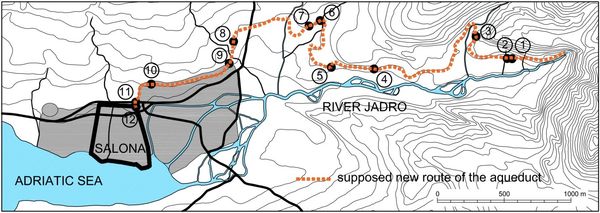
Positions of the archaeological probes
During 2015, intensive archaeological research was carried out, namely:
January
- three sites, where the aqueduct had been previously archaeologically researched, were cleared (probes 1, 2 and 3 in December 2014)

Probe 1


Probe 2

Probe 3
March
- two probes were dug at about 400 metres from the Jadro river spring (probes 6 and 7) at a high ground within the marlstone quarry
- an archaeological probe from 2004 (probe 8) was cleared of vegetation and soil because the researchers were unable to trace the documentation related to these researches. Remains of the channel with coverings and a revision shaft were discovered here, measuring 15 metres long.

Probe 8
- east of the Zakulić creek, a reconnaissance of the terrain at the presumed site led to the discovery of the Roman channel remains, intersected by recent construction works (probe 9).

Probe 9
June
- at the Pozirala site (probe 12), the channel inner wall remains were discovered, measuring 4 metres long.
August
- the cross-section of the channel north of the Salona thermae (probe 11) was researched and, at the site of the Roman road at Zgon (probe 10), the researches attempted to find the channel assumed to have existed there by archaeologist Katić. However, the channel has not been found under the dirt road, thus its actual position can be assumed north of the road, within a privately-owned garden.

Probe 11
All the archaeological probes were topographically and architecturally recorded, and an archaeological report was made. The archaeological works and topographic surveying were carried out by archaeologists Anita Penović Lovrić and Nebojša Cingeli and geodesist Klara Šolić from the Split company Neir d.o.o. The architectural survey and the topographic maps were produced by Katja Marasović and Snježana Perojević.
Results
The route previously assumed to have had connected the five known channel sites in a straight line has been significantly amended by the detailed analysis of the terrain configuration and by the discovery of the channel remains at four additional sites. It was discovered that the route actually wriggled, strictly following the configuration of the terrain, without overcoming valleys by building bridges. The average channel longitudinal slope amounts to 0.2% and the total length from the Jadro river spring to Porta Cesarea amounts to 4,700 metres.
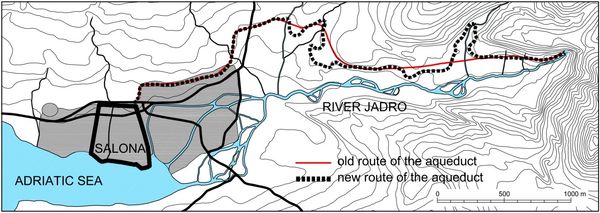
The old and the new route of the Aqueduct of Salona
Numerous typical channel cross-sections were found, which are related to the slope of the terrain at which the channel was built.

Reconstruction of the channel cross-section according to the findings in the archaeological probes (the number next to the cross-section indicates the number of the corresponding archaeological probe)
Activities during 2016

The research team in front of the entrance to Salona - Bojanić, Marasović, Margeta, Perojević and Katić (from left to right)
During 2016, research of the water supply and sewerage system of Salona was carried out, and archaeological research was performed at multiple locations.
All the archaeological probes were topographically and architecturally recorded, and an archaeological report was made. The archaeological research work and topographic surveying was carried out by the company Neir d.o.o. from Split, namely: archaeologists Anita Penović Lovrić and Nebojša Cingeli and geodesist Klara Šolić. The map of the wider Salona area was made by volunteers: Irena Margeta, M.S.Arch.; Olgica Erceg, M.S.Civ.Eng.; Tajana Pandžić, M.S.Arch.; Anka Ban, M.S.Arch.; and Nikola Marčić, candidate for M.S.Civ.Eng.

The researchers with their associates in Salona
Public presentations and papers published in 2016 (link)
- Marasović, Katja; Margeta, Jure; Perojević, Snježana; Katić, Miroslav; Bojanić, Davor.: The Aqueduct of the Roman Town Salona – Croatia // 4th IWA International Symposium on Water and Wastewater Technologies in Ancient Civilizations / Angelikis, Andreas ; Conceicao Cunha, Maria (ur.). Coimbra : University of Coimbra, 2016. 1-11 (predavanje, međunarodna recenzija, objavljeni rad, znanstveni) - link.
- Marasović, Katja; Perojević, Snježana; Margeta, Jure: Antički vodovodi u Dalmaciji // Sabor hrvatskih graditelja 2016, Eu i hrvatsko graditeljstvo / Lakušić, Stjepan (ur.). Zagreb : Hrvatski savez građevinskih inženjera, 2016. 867¬878 (predavanje, domaća recenzija, objavljeni rad, stručni) - link.
- Margeta, Jure; Marasović, Katja: Dioklecijanov vodovod, Festival znanosti, Split 2016. (javno izlaganje) - link.
- Marasović, Katja: Water system of Diocletian’s palace in Split, Roman Urban Water Networks Workshop, Edinburgh, 2 December 2016
- Margeta, Jure: Analysis of urban water systems of the ancient roman city of Salona and Diocletian’s palace: an engineering approach, Roman Urban Water Networks Workshop, Edinburgh, 2 December 2016.
Activities during 2017
Consultant visit
French architect Jean-Louis Paillet has stayed in Split from 29 May to 7 June, acting as the Project consultant. During this visit, working was organised by the following topics:
1. reception of Jean-Louis Paillet by Professor Boris Trogrlić, Dean of the Faculty of Civil Engineering, Architecture and Geodesy (the Institution by which the Project is being conducted),
2. introducing Jean-Louis Paillet to our previous research results by means of a lecture and a field tour (Salona, the Palace, and the remains of the two Aqueducts at various locations).
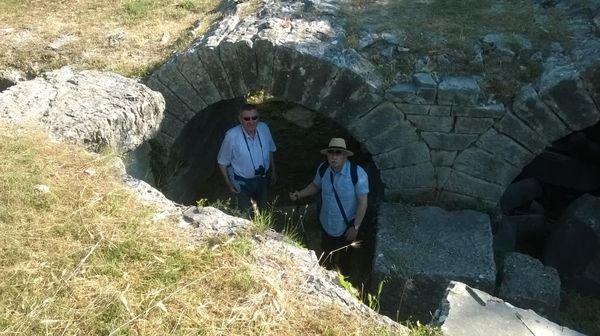
J.L. Paillet and Jure Margeta in Salona
3. presentation delivered by Jean-Louis Paillet to the members of the research team on his own experiences in exploring water systems in France and Italy.
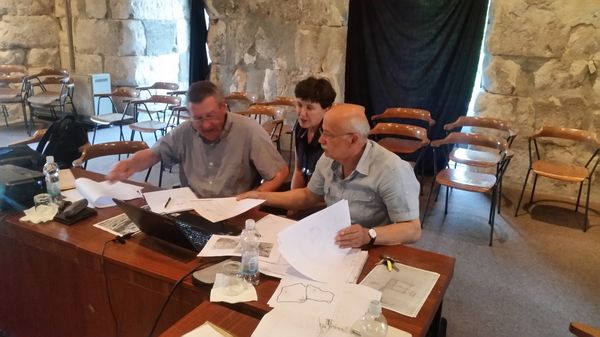
J.L. Paillet, Katja Marasović and Jure Margeta
4. discussion on individual segments of the water supply systems of Salona and the Diocletian's Palace.
5. public presentation by Jean-Louis Paillet entitled “Two Roman Aqueducts of Glanum at Saint-Remy-de-Provence”, held on 2 June 2017 at the premises of “Alliance Francaise de Split”, organised by the Faculty of Civil Engineering, Architecture and Geodesy.
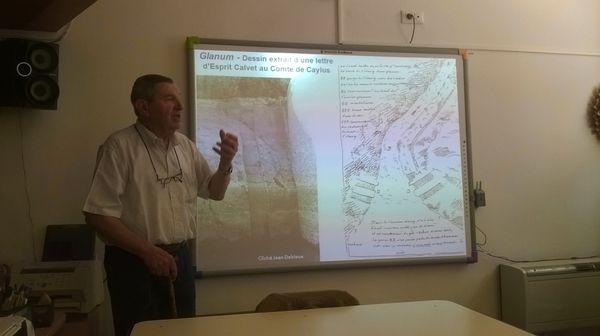
J.L. Paillet during the presentation
Research Work
Archaeological research of the sewerage system of the Diocletian's Palace at the eastern end of decumanus, March 2017.
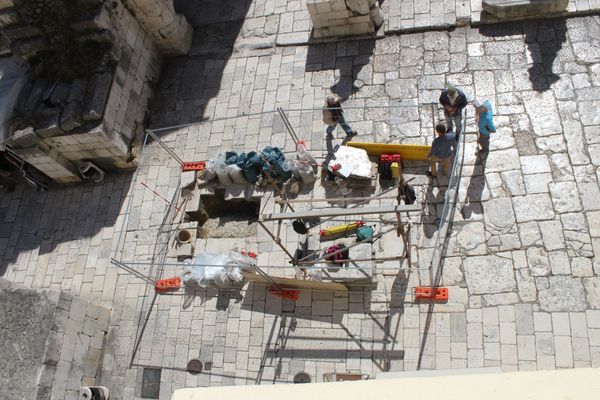
A view on the archaeological probe from the nort
Public Presentations and Publications in 2017
Participation in conferences and symposiums
1. Katja Marasović, presentation entitled "Water supply during the Time" at the symposium -, Rotary forum, "WATER", Split 8 April 2017; link
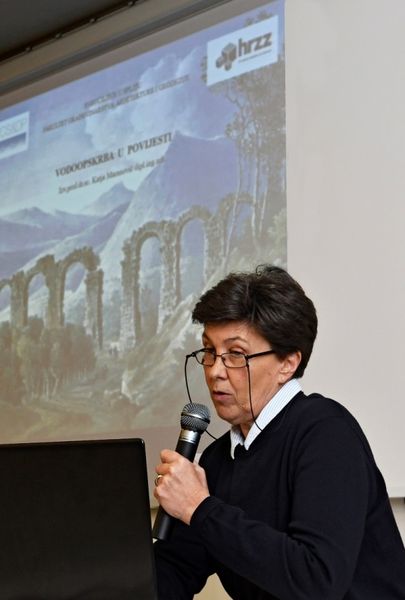
Katja Marasović at the forum on water in Split
2. Interview by journalist Vedrana Krstić Ivanišević with Katja Marasović regarding her “Water supply during the Time” lecture delivered at the Rotary forum “WATER”, Radio Split, Morning programme, April 17, 2017
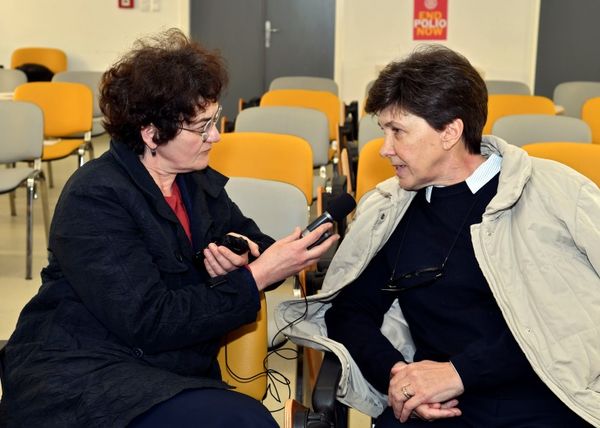
Interview by journalist Vedrana Krstić Ivanišević with Katja Marasović
3. Jure Margeta and Katja Marasović, lecture entitled “Water Supply System of the Roman City of Salona”, Festival of Science, Split, 26 April 2017; link
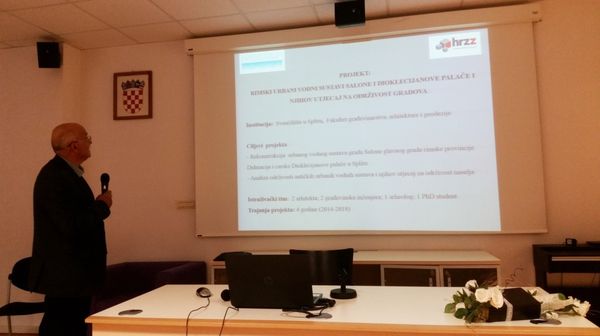
Jure Margeta, presentation at the Festival of Science, 2017
4. Katja Marasović, on behalf of her co-authors Snježana Perojević and Jure Margeta, participated in the “CURA AQUARUM, ADDUZIONE E DISTRIBUZIONE DELL'ACQUA NELL ANTICHITA” archaeological symposium in Aquileia (Italy) from 10 – 12 May 2017 with the presentation entitled “L'approvigionamento dell'acqua nel palazzo di Diocleziano” (Water supply of the Diocletian's Palace); link
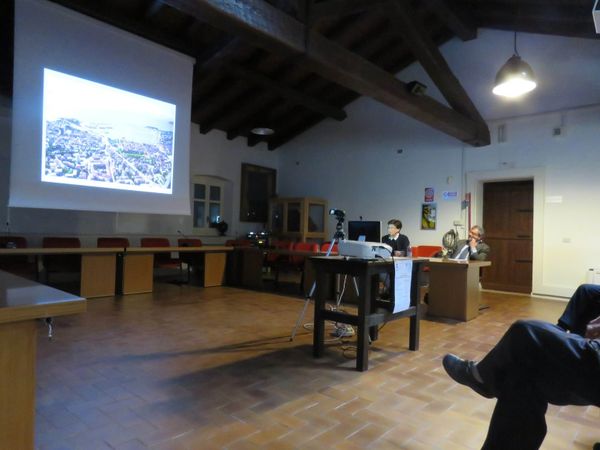
Katja Marasović at the symposium in Aquileia
5. Presentation by Jure Margeta, on behalf of his co-authors Katja Marasović, Snježana Perojević, Miroslav Katić, Anita Penović, Nebojša Cingelia, Ivica Pleština and Davor Bojanić, at the archaeological symposium entitled "SURROUNDINGS OF THE KAŠTELA BAY IN THE PAST", organised by the Croatian Archaeological Society and the Museum of the City of Kaštela and held in Kaštel Lukšić from 2 to 6 October 2017, entitled "MULTIDISCIPLINARY RESEARCH OF THE ROMAN URBAN WATER SYSTEM OF SALONA"; link

Jure Margeta, presentation in Kaštela
6. Interview by journalist Dražen Duilo with Jure Margeta and Katja Marasović related to the Project research results, Slobodna Dalmacija, 15 November 2017; link
Published papers
1. Marasović, Katja; Margeta, Jure; Perojević, Snježana; Bojanić, Davor; Katić, Miroslav. The aqueduct of the Roman town Salona – Croatia. // Water Science and Technology-Water Supply. 17 (2017) , 4; 929-939 (članak, znanstveni); - link
2. Marasović Katja; Margeta, Jure. Istraživanje antičkih vodnih zahvata na izvoru rijeke Jadro. // Vjesnik za arheologiju i historiju dalmatinsku. XXX (2017) , 99; 509-532 (članak, znanstveni); - link
3. Margeta Jure, Marasović Katja. “Roman Water Systems of Salona and the Diocletian’s Palace and Their Impact on the Sustainability of the Urban Environment”, IWA (International Water Association) News Letter - u tisku
4. Jure Margeta; Katja Marasović; Snježana Perojević; Miroslav Katić; Anita Penović; Nebojša Cingeli; Ivica Pleština; Davor Bojanić. INTERDISCIPLINARNA ISTRAŽIVANJA ANTIČKOG URBANOG VODNOG SUSTAVA SALONE // Okolica Kaštelanskog zaljeva u prošlosti., Kaštela 2017., 11-11, (sažetak,znanstveni); link